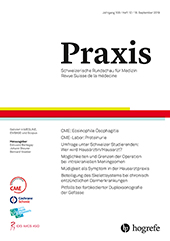Intrakranielle Meningeome: ein neurochirurgisches Krankheitsbild?
Möglichkeiten und Grenzen der Operation
Abstract
Zusammenfassung. Meningeome sind die häufigsten intrakraniellen Tumoren. Entsprechend der WHO-Klassifikation werden sie in drei WHO-Grade eingeteilt. Die meisten Meningeome sind WHO I und mittels mikrochirurgischer Resektion komplett und kurativ behandelbar. Die bildgebende Diagnostik und die Nachkontrollen erfolgen mittels MRI. Asymptomatische Meningeome können kontrolliert werden. Symptomatische Meningeome und Meningeome mit Lagebeziehung zu neuralen und vaskulären Strukturen sollten mikrochirurgisch operiert werden unter Zuhilfenahme moderner Operationstechniken (Neuromonitoring, Navigation, minimal-invasive Verfahren). Die Rezidivrate wird durch das Ausmass der Resektion entsprechend der Simpson-Klassifikation und die histologische Dignität des Tumors bestimmt. Bei subtotaler Resektion, komplexen Tumoren, Rezidiven sowie höhergradigen Meningeomen sollte der Einsatz radiotherapeutischer und radiochirurgischer Massnahmen interdisziplinär diskutiert werden.
Abstract. Meningiomas are the most common intracranial tumors. According to the WHO classification they are categorized as WHO I–III. Most meningiomas are WHO I and can be treated by complete microsurgical resection and thus cured. Imaging and controls should be performed using MRI. Asymptomatic meningiomas can be observed. Symptomatic meningiomas and meningiomas in proximity to neural and vascular structures should be resected microsurgically using modern techniques such as neuromonitoring, neuronavigation and minimally invasive techniques. The recurrence rate is determined by the extent of resection according to the Simpson classification and the histological grading of the tumor. With subtotal resection, complex tumors, recurrences and higher grade meningiomas the use of radiotherapy or radiosurgical treatment should be discussed in a tumor board.
Résumé. Les méningiomes sont les tumeurs intracrâniennes les plus courantes. Selon la classification de l’Organisation Mondiale de la Santé, ils sont divisés en trois degrés. La plupart des méningiomes sont ceux de l’OMS I et peuvent être traités complètement et curativement par résection microchirurgicale. Le diagnostic par imagerie et les contrôles de suivi sont effectués par IRM. Les méningiomes asymptomatiques peuvent être contrôlés. Les méningiomes symptomatiques et les méningiomes ayant une relation positionnelle avec les structures neurales et vasculaires doivent être opérés au microscope en utilisant des techniques chirurgicales modernes (neuromonitoring, navigation, procédures minimal-invasives). Le taux de récidive est déterminé par l’étendue de la résection selon la classification de Simpson et le degré histologique de la tumeur. Dans le cas d’une résection sous-totale, de tumeurs complexes, de récidives et de méningiomes de haut degré, l’utilisation de mesures radiothérapeutiques ou radiochirurgicales devrait faire l’objet d’une discussion interdisciplinaire.
Bibliografie
: Pathology of meningiomas. J. Neurooncol 1996; 29: 217–221.
: Pathological classification and molecular genetics of meningiomas. J. Neurooncol 2010; 99: 379–391.
, : The 2016 World Health Organization Classification of tumors of the central nervous system: a summary. Acta Neuropathol 2016; 131: 803–820.
: CNS Tumors in Neurofibromatosis. J Clin Oncol 2017; 35: 2378–2385.
: Handbook of Neurosurgery. 8th ed. Stuttgart; Thieme.: 2016.
, : Intradural spinal tumors in adults-update on management and outcome. Neurosurg Rev 2018; 42: 371–388.
: Brain tumors. Oxford; Oxford University Press: 1999.
, : EANO guidelines for the diagnosis and treatment of meningiomas. Lancet Oncol 2016; 17: e383–391.
, : Meningiomas: knowledge base, treatment outcomes, and uncertainties. A RANO review. J Neurosurg 2015; 122: 4–23.
: The recurrence of intracranial meningiomas after surgical treatment. J Neurol Neurosurg Psychiatry 1957; 20: 22–39.



